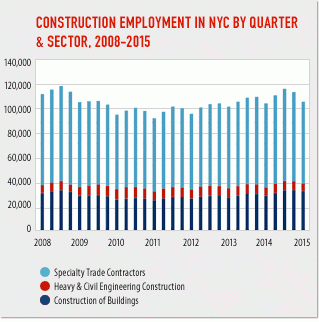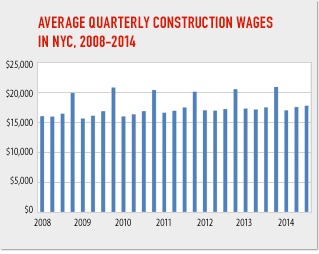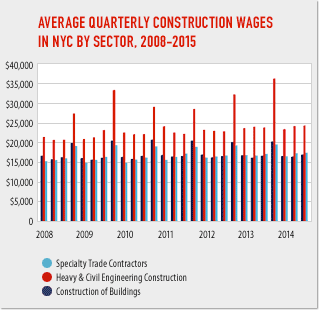
NYC construction employment rose 4.5 percent in 2014, while wages remained flat
Private sector construction employment in New York City increased by 4.5 percent in 2014 and is up by 10 percent since 2012, according to a New York Building Congress analysis of New York State Department of Labor employment statistics. Despite the strong jobs growth, construction wages have remained relatively flat in recent years.
Employment
New York City construction employment averaged 127,600 private sector workers in 2014, up from 122,100 in 2013, 116,000 in 2012, and 112,200 in 2011. After three consecutive years of construction job growth, 2014 industry employment stood at just 3.2 percent below the peak level of 131,800 jobs that were created during the height of the previous construction boom in 2008.
Construction employment also rose slightly in the first quarter of 2015, with 121,200 private sector jobs compared to 119,600 jobs in the first three months of 2014. In fact, this year’s first quarter employment total is the second highest over the past 25 years – trailing only the 128,300 jobs produced in the first quarter of 2008. (Employment in the construction sector is lower in the first quarter of each year as companies reduce employees on payroll during the winter months in anticipation of inclement weather.)
The specialty trades sector, which includes plumbers and electricians, accounted for 83,000 jobs in 2014, up from 80,000 jobs in 2013. Workers involved in the construction of buildings accounted for 36,100 jobs last year, up from 33,300 the prior year. The heavy construction and civil engineering sector produced 8,400 jobs, down from 8,900 in 2013.
“All of those cranes that are dotting the skyline, as well as the sidewalk bridges that have proliferated throughout the five boroughs, represent thousands of good paying jobs for New York City residents,” said Building Congress President Richard T. Anderson. “Like overall spending, the recent data on employment serve as indications of a construction market that is even stronger than we anticipated last fall. If the trend continues in 2015, we can expect to see construction employment reach 130,000 for just the second time in this decade.”
Wages
The jobs picture in the construction industry is mirroring the larger economy in that wage growth is not keeping up with employment increases.
Average wages earned by construction workers in the private sector rose less than one percent in the first nine months of 2014 (the latest period for which data are available). Construction workers in New York City earned an average of $52,300 through September 2014, compared to $52,000 for the same period in 2013, and $51,200 during the first nine months of 2012.
Given that earnings are generally the greatest in the fourth quarter due to year-end bonuses, it is safe to assume that annual earnings in 2014 will end up in the $73,000 range, as was the case in 2013. In 2012, earnings for the entire year averaged $71,800 per worker.
Those involved in heavy and civil engineering construction are the highest paid workers, averaging $107,900 in 2013, up from $101,600 in 2012 and $97,500 in 2011.
Wages for the New York City workforce involved in the construction of buildings have stagnated. These workers averaged $70,200 in earnings in 2013, compared to $70,100 in 2012 and $70,600 in 2011.
Workers employed by specialty trades contractors have experienced modest recent wage growth – from $68,300 in 2011 and $68,900 in 2012 to $70,300 in 2013.
“While there are likely a number of factors at play, it certainly seems as though the increased use of non-union labor is playing a role here,” said Mr. Anderson. “Consider that annual wages have increased by 19 percent between 2008 and 2013 for heavy and civil engineering workers, who remain highly unionized, but just 2 percent for buildings workers and 6 percent for specialty trades workers, where nonunion labor has made significant inroads in recent years. If the construction market continues to strengthen as anticipated, it will be interesting to see if further increases in demand for labor exert an upward pressure on wages.”
Charts and Diagrams

Source: Covered Employment Survey (CES), a cooperative program between the State of New York and the U.S. Bureau of Labor Statistics

Source: Quarterly Census of Employment and Wages (QCEW), New York State Department of Labor

Source: Quarterly Census of Employment and Wages (QCEW), New York State Department of Labor



